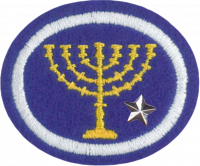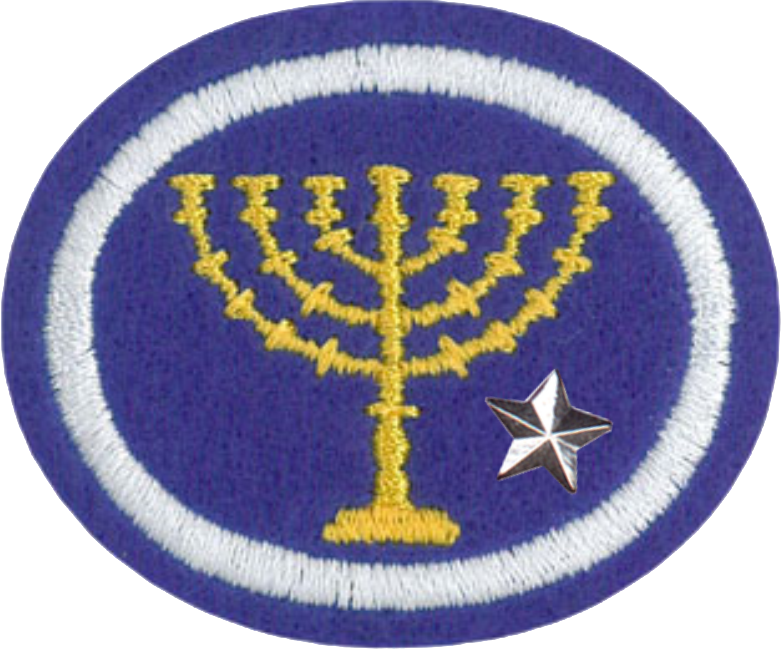Especialidades JA/Santuario - Avanzado/Respuestas
Nivel de destreza
3
Año
2019
Version
06.12.2025
Autoridad de aprobación
División Norteamericana
Prólogo
1
2
2a
2b
Por tanto, teniendo un gran Sumo sacerdote que traspasó los cielos, Jesús el Hijo de Dios, retengamos nuestra profesión. No tenemos un sumo sacerdote que no pueda compadecerse de nuestras debilidades, sino uno que fue tentado en todo según nuestra semejanza, pero sin pecado. Acerquémonos, pues, confiadamente al trono de la gracia, para alcanzar misericordia y hallar gracia para el oportuno socorro.
Lea Hebreos 9:1 al 10:22 siguiendo el vínculo aquí.
3
3a
“Now this is what you shall offer on the altar: two lambs of the first year, day by day continually. One lamb you shall offer in the morning, and the other lamb you shall offer at twilight. With the one lamb shall be one-tenth of an ephah of flour mixed with one-fourth of a hin of pressed oil, and one-fourth of a hin of wine as a drink offering. And the other lamb you shall offer at twilight; and you shall offer with it the grain offering and the drink offering, as in the morning, for a sweet aroma, an offering made by fire to the Lord. This shall be a continual burnt offering throughout your generations at the door of the tabernacle of meeting before the Lord, where I will meet you to speak with you.
“And you shall say to them, ‘This is the offering made by fire which you shall offer to the Lord: two male lambs in their first year without blemish, day by day, as a regular burnt offering. The one lamb you shall offer in the morning, the other lamb you shall offer in the evening, and one-tenth of an ephah of fine flour as a grain offering mixed with one-fourth of a hin of pressed oil. It is a regular burnt offering which was ordained at Mount Sinai for a sweet aroma, an offering made by fire to the Lord. And its drink offering shall be one-fourth of a hin for each lamb; in a holy place you shall pour out the drink to the Lord as an offering. The other lamb you shall offer in the evening; as the morning grain offering and its drink offering, you shall offer it as an offering made by fire, a [a]sweet aroma to the Lord.
Read Leviticus 16 by following the link here.
I beseech you therefore, brethren, by the mercies of God, that you present your bodies a living sacrifice, holy, acceptable to God, which is your reasonable service. And do not be conformed to this world, but be transformed by the renewing of your mind, that you may prove what is that good and acceptable and perfect will of God.
Leviticus chapters 1, 4, and 5 talk about forgiveness sacrifices which are also part of daily sacrifice rituals, but it was felt that the sheer quantity of reading might put it out of reach for many young people. Thus, a summary or quick scan might be appropriate. The texts about the corporate daily sacrifice are listed as part of the requirement.
According to the SDA Encyclopedia (SDA Bible Commentary, Vol. 10), Jesus ministered (as our High Priest) in the Holy Place of the heavenly sanctuary from His ascension until 1844. During this time, the forgiven sins of Christians were transferred to the heavenly sanctuary. In 1844, He entered the Most Holy Place, or Holy of Holies, to cleanse the heavenly sanctuary of its defilement. In the final judgment, the sins of all true Christians will be transferred to Satan, who is symbolised by the scapegoat. When that work is done, Jesus comes back in the splendor of the Second Coming to take His forgiven and saved people to Heaven to live with Him. (SDABC, Vol. 10, pg. 533-539).
Personal discussion or journaling as outlined in this requirement is REFLECTIVE rather than definitive in nature. Notice that the goal is PERSONAL! The instructor should be sensitive to the felt needs and personal expressions shared (or kept private) for this requirement. If studying with those who are skeptical of this application of prophecy, be sensitive and ask them to reflect on how they feel when they realize HOW MUCH GOD LOVES THEM, and when they realize HOW LONG God has had a plan for THEIR salvation.
3b
And he said to me, “For two thousand three hundred days; then the sanctuary shall be cleansed.”
Further depth for this prophecy can be found in the Prophets & Prophecy - Advanced honor. The purpose of this requirement is for a simple introduction of the ongoing role of the sanctuary into modern times.
Quoted from 101 Questions on the Sanctuary and Ellen White (1981):
How can October 22, 1844, be found in Daniel 8:14? A detailed answer is given in the Seventh-day Adventist Bible Commentary. Basic to the Adventist interpretation are the following five points: (1) Both the 2300 days of Daniel 8 and the seventy weeks of Daniel 9 are to be explained on the year-day principle (that is, one prophetic day equals one calendar year). (2) The seventy weeks form the first part of the 2300-day prophecy, and thus both have the same starting point. (3) The “commandment to restore and to build Jerusalem,” which begins the two time periods, went forth with the decree of Artaxerxes in 457 BC. (4) When these time periods are begun at 457 BC we arrive at 27 AD for Christ’s baptism, 31 AD for His crucifixion, and 1844 for the cleansing of the sanctuary. (5) The cleansing of the sanctuary in 1844 commenced on the day in that year when the Jewish Day of Atonement occurred, which was October 22.
4
This is personal journaling and relational time with no “wrong answers.” If anything, it could illuminate instructors as to the depth of spiritually already at work in the lives of participants, along with their desires to have a deeper and more intentional experience. Celebrate each discussion point. Value each brave expression. Affirm each one!
4a
4b
4c
4d
4e
5
5a
5b
5c
6
7
7a
The key word is THEMES. There is a lot of Christian music in a variety of genres (gospel, country western, pop, rap, praise and worship, etc.) that speak to the themes of the Sanctuary (such as forgiveness, God dwelling with His people, God answering prayer, Christ’s judgement, Christ’s second coming, etc.) The goal is to develop a meaningful playlist and be able to defend these choices.
7b
The key word is THEMES. Poetry, music lyrics, and the voice overs/animation whiteboard combo can all explain what they believe are themes of the Sanctuary. Encourage participants to focus on themes of relevance to today’s world rather than those relevant to Old Testament Israelites!
7c
This prayer walk can include PICTURES or MUSIC SELECTIONS for each step/part of the Sanctuary. It has been adapted from Derek Morris’s Life and Teachings class taught at SAU in the 1990s, and was adapted by a Bible teacher in Tennessee, Jeff Lauritzen. The Bible texts included could be practiced and read, or played from recordings. The goal is to make this a meaningful experience for the participants. It will require planning so that the walk is reverent, thoughtful, timely, and meaningful to the participants. Involving deaconesses, elders, or other ministry leaders to help plan and lay out this experience is ideal!
Enter at the GATE: Thanksgiving and Praise
- Psalm 100:4 “Enter His gates with thanksgiving and His courts with praise.”
- Praise God for who He is and thank Him for what He has done.
- Consider praying your way through one of the psalms of praise, e.g. Psalm 138.
- Linger at the ALTAR: Forgiveness
- Claim John 3:16 “For God so loved the world that He gave...”
- Claim John 6:37 “He (she) that comes to me I will in no wise cast out.”
- Confess your sin at the altar.
- Acknowledge Jesus’s death for your sin. Thank Him for loving you so much.
- Offer yourself to Him. Give Him permission to make your life something amazing for Him.
Visit the LAVER: Cleansing
- 1 John 1:9 “If we confess our sins, He is faithful and just to forgive us our sins and cleanse us form all unrighteousness.”
- Claim this promise for forgiveness AND cleansing.
- Ask God to truly cleanse you from anything that comes between you and Him.
Stop at the CANDLESTICK: The Holy Spirit/Joy
- Luke 11:13 “He will give the Holy Spirit to those who ask for it.”
- Galatians 5:22 “The fruits of the Spirit are love, joy, peace” etc.
- Claim the promise of Luke 11:13, and ask that the Spirit’s fruit will be seen in your life.
Sit down at the TABLE OF SHEWBREAD: Time with God, Provision and protection.
- Claim Psalm 23:5 “You prepare a table before me in the presence of my enemies.”
- Visualize actually doing Ephesians 6:17 - Take the Helmet of salvation... the sword of the spirit, etc.
Kneel at the ALTAR OF INCENSE: Prayer
- Claim James 5:16 “The prayers of a righteous man (woman) avails much.”
- Pour out your heart to God. Pray for yourself and others in your life.
Finish at the ARK OF THE COVENANT: Come into His presence
- Hebrews 4:16 “Let us come boldly before the throne of grace... to obtain mercy and find grace
to help in time of need.”
- “God, You’ve invited me, and here I am!”
- Praise God for loving you so much that He WANTS you in His presence. Bask in the knowledge that you can live in the presence of a God who is crazy about you.
7d
You may wish to review what symbolism the Hebrews saw in each piece and also reflect on what you have learned about the significance of that symbol for Christians today as your write your prayer.
7e
Bible texts, songs, Bible stories, and of course truths discovered during this honor can be shared as a background to forgiveness. We encourage the retelling of the Day of Atonement Bible story in summary.
Directions for one such culminating activity: This activity allows the participants to gather in a safe environment. Provide paper and pencils. Encourage them to tell the truth to God — the specific details of their personal brokenness — so they can offer specific prayer rather than the blanket prayer of “please forgive my sins.” Invite them to write on paper the specific sins they would like to confess (it will be for their eyes only). Allow them to spread out throughout the space for quiet time with God (music in background is a great idea) as they write. When time is up and the participants have returned, invite them to scrunch up their papers and place them on the altar that was made beforehand. (Can be made of foil and cardboard with a small tin inside that is the "burning pot." Another option is having a paper shredder surrounded by an alter shaped structure. Either way, the goal is to DESTROY the papers with their sins/confessions listed). Just as their papers disappear, never to be readable again, so their sins are forgiven forever by their High Priest. Close with a simple Bible text that the participants have resonated with during their honor study, then a closing prayer. Ideally, the leader has worked with the team planning this service, and one or more of them take lead on all aspects. However, in some situations, the group may feel most confident if the leader or their pastor facilitates the culminating activity.


